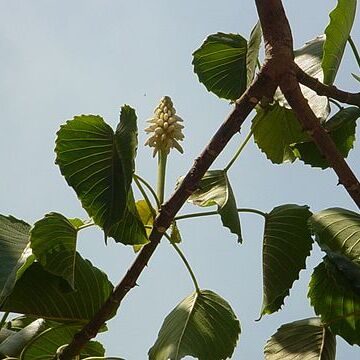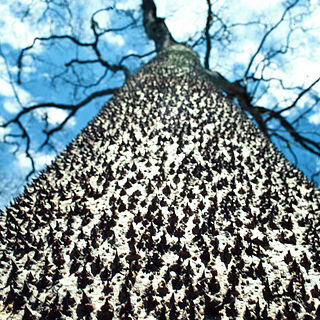Trees, branching usually in whorls; trunk and branches spiny; indumentum of simple, multicellular hairs; white latex present. Leaves alternate; stipules large, caducous; petioles 2-glandular at apex; leaf blade subentire or undulate-serrulate, pinnately veined. Plants monoecious. Inflorescences terminal or axillary, unbranched, elongate. Male flowers in terminal, long pedunculate catkin; bracts not glandular, united into membranous sheath around bud, afterward irregularly lobed; calyx membranous, shallowly cup-shaped, truncate or slightly serrulate; petals absent; disk absent; stamens (8-)10-20, several-seriate; filaments and connectives united into a stout column, theca free, extrorse, longitudinally dehiscent; pistillode absent. Female flowers solitary, axillary; pedicel long; calyx leathery, broadly cup-shaped, truncate at apex; petals absent; disk absent; ovary 5-20-celled; ovules 1 per locule; styles fused into prominent, fleshy column; stigmas united into large umbrella-shaped lobed disk. Fruit a large, oblate schizocarp, depressed at apex, breaking up into laterally compressed woody mericarps. Seeds laterally compressed, smooth; caruncle absent; endosperm fleshy; cotyledon rounded and flattened.
Trees, monoecious; trunk with broad-based, conic thorns; hairs unbranched; latex white or colorless. Leaves deciduous, alternate, simple; stipules present, caducous; petiole present, glands present at apex, lateral, conspicuous; blade unlobed, margins serrate or crenate-serrulate, laminar glands absent; venation pinnate. Inflorescences usually unisexual, rarely bisexual (pistillate flowers proximal, staminate distal); staminate terminal, spikelike thyrses, cymules densely crowded in conelike structure; pistillate axillary, solitary flowers; bisexual as in staminate with solitary pistillate flower at base; glands subtending each bract 0. Pedicels present. Staminate flowers: sepals 5, imbricate, connate most of length; petals 0; nectary absent; stamens 10–80, connate entire length forming thick column; pistillode absent. Pistillate flowers: sepals 5, connate entire length; petals 0; nectary absent; pistil 5–20-carpellate; style 1, unbranched, terminating in lobed stigmatic disc. Fruits capsules, woody. Seeds lenticular; caruncle absent. x = 11.
Trees, trunk with hard conical spines; monoecious. Leaves alternate, simple, long-petiolate, with 2 round glands at junction with blade; stipules caducous. Inflorescences unisexual. Staminate flowers in terminal long-pedunculate fleshy conical spikes, each flower sheathed by a membranous bract which ruptures at anthesis, sessile; calyx cupulate, denticulate; disc absent; stamens numerous, the filaments connate, the anthers in 2-several verticels, longitudinally dehiscent; pol-len grains oblate, ternate, 3-colporate. Pistillate flowers solitary in uppermost leaf axils or rarely at base of male spike, long-pedicillate; calyx broad-cupulate, 5-toothed to subentire; disc absent; ovary of 5-20 carpels, each with a single ovule, the styles connate into a long column, dilated into radiating lobes at the apex. Fruit an explosively dehiscing woody capsule; seeds laterally compressed, ecaruncu-late.


